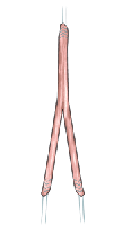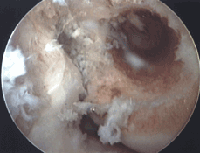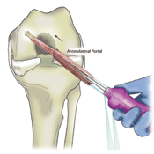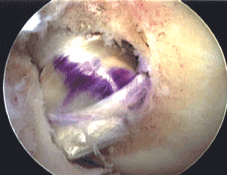Arthroscopic PCL reconstruction with a soft tissue system
|
|
by Champ L. Baker Jr., MD, and Champ L. Baker III, MD
Surgical management of posterior cruciate ligament (PCL) injuries continues to evolve because of recent anatomical and biomechanical investigations. Despite improved understanding of the basic science of the PCL, a lack of consensus remains regarding the optimal reconstructive technique.Current controversies include single-bundle vs. double-bundle reconstruction; transtibial vs. tibial inlay technique; graft choice and graft tensioning. Currently, our preferred method for PCL reconstruction is an arthroscopically assisted single-bundle transtibial technique with a soft tissue allograft.
Patient positioning
|
Image: Cayenne Medical |
The patient is positioned supine on the operating table and a complete examination under general anesthesia is performed with careful evaluation for associated ligamentous injuries. The operative extremity is placed in an arthroscopic leg holder and a thigh tourniquet is applied. The foot of the table is dropped leaving the knee flexed 90° and ensuring C-arm access to the knee. The leg is then prepared and draped in the usual sterile fashion.
The procedure is performed under tourniquet control. A standard anterolateral portal is created and diagnostic arthroscopy is performed. An anteromedial portal is made under direct visualization. After addressing associated chondral and meniscal pathology, the PCL injury pattern is noted. The PCL remnant is debrided with a motorized shaver and electrothermal device. We preserve a small amount of the PCL femoral footprint to identify the true origin of the ligament.
The 30° arthroscope is then directed into the back of the knee to view the posteromedial compartment. Under direct visualization with a spinal needle, a posteromedial portal is created. Insertion of a clear threaded cannula allows the surgeon to easily alternate the arthroscope and instrumentation from the anterior portals to the posteromedial portal. When placed in the anterolateral portal, the 70° arthroscope provides improved visualization of the tibial insertion. The insertion is debrided thoroughly with a combination of a shaver and curette placed in either an anterior or the posteromedial portal.
Graft preparation
Our current graft choice for single-bundle transtibial PCL reconstruction is an anterior tibialis allograft at least 9 mm in width and 240 mm in length. The graft is thawed on the back table and prepared for use with the AperFix femoral fixation device (Cayenne Medical, Inc.). The graft is first split longitudinally half of its length. The unsplit graft end is then secured with a #2 FiberLoop (Arthrex, Inc.) for approximately 25 mm, while the remaining two split tails of the graft are similarly sutured with a #2TigerLoop (Arthrex, Inc.; Figure 1). The graft is doubled over and pulled through a graft-sizing block to determine the diameter of the implant to be used. Typically for a 9-mm graft, a 10-mm implant is warranted. Both prepared split tails of the graft are passed through the orifices of the AperFix femoral implant, and the sutures are tensioned tightly on the insertion handle. The graft is then marked at the level of the inferior edge of the implant to serve as the aperture depth indicator.
|
Image: Baker CL |
Image: Baker CL |
|
Tibial tunnel preparation
|
Image: Cayenne Medical |
A PCL-specific tibial guide set at 50° to 55° is introduced through the anteromedial portal. It is positioned approximately 1.5 cm distal to the posterior joint line, just slightly lateral in the sagittal plane. Guide positioning is aided and confirmed with the combined use of fluoroscopic imaging and viewing from the posteromedial portal. A small incision is made over the proximal anteromedial tibia midway between the tibial crest and posteromedial border. Through this incision the tibial guide is set on bone, and the guide pin is advanced under fluoroscopic control to and, carefully, through the posterior tibial cortex. A curette can be inserted through the posteromedial portal to prevent iatrogenic pin advancement. Final pin position is confirmed with a lateral fluoroscopic image. Next, the guide pin is carefully overreamed with a cannulated reamer typically one size larger than the graft diameter to facilitate later graft passage.
Femoral tunnel preparation
The 30° arthroscope is then reinserted into the anteromedial portal, through which a guide pin is directed into the center of the preserved PCL femoral footprint. This is approximately 6 mm posterior to the articular surface of the medial femoral condyle at the 2 o’clock position in a right knee — 10 o’clock position, left knee. In this position, we try to recreate the anterolateral bundle of the PCL.
The guide pin is advanced sufficiently into the medial femoral condyle and then overreamed with a cannulated reamer to a depth of 35 mm to 40 mm. The diameter of the femoral tunnel corresponds to the size of the AperFix implant which is typically 10 mm (Figure 2).
Graft Passage and Fixation
|
Image: Baker CL |
A Gore Smoother (WL Gore & Associates) is placed retrograde through the tibial tunnel and delivered into the posterior compartment. The leading loop is brought out of the knee through the anterolateral portal with a grasper. The Gore Smoother is then gently cycled to remove debris and smooth any rough bone edges to facilitate graft passage. The loop is maintained out the anterolateral portal. The prepared insertion device is inserted through the anterolateral portal directly into the femoral socket to the appropriate depth as marked on the graft (Figures 3A and 3B). Difficulty inserting the graft is minimized with an enlarged anterolateral portal and by maintaining the same knee flexion angle as when the femoral tunnel was drilled.
The device is deployed providing aperture tendon-to-bone compression. The sutures are removed from the insertion handle, and the entire insertion device is removed from the knee. The sutures from the graft ends are then placed into the Gore Smoother loop out of the anterolateral portal. As the Gore Smoother is pulled distally, the graft sutures are shuttled through the joint and out the tibial tunnel. Tension is then placed on the sutures to pass the graft ends into the tibial tunnel (Figure 4). A switching stick or probe can be used through the posteromedial portal as a fulcrum to ease graft passage around the posterior tibia and into the tunnel.
With tension applied to the graft, the knee is cycled through a full range of motion and then held at 90° of flexion. With an anterior drawer force applied to the proximal tibia, tibial fixation is achieved with the tibial insertion device consisting of a screw and two-part sheath sized to match the tunnel diameter (Figure 5).
Although no consensus exists regarding the ideal PCL reconstruction technique, we believe the current method described provides secure, rigid fixation in a reproducible fashion. Future biomechanical and clinical outcomes studies are needed for comparison to other established methods.
References:
- Bergfeld JA, Graham SM, Parker RD, et al. A biomechanical comparison of posterior cruciate ligament reconstruction using single- and double-bundle tibial inlay techniques. Am J Sports Med 2005; 33:976-981.
- Edwards A, Bull AM, Amis AA. The attachments of the fiber bundles of the posterior cruciate ligament: an anatomic study. Arthroscopy. 2007;23:284-290.
- Harner CD, Janaushek MA, Kanamori A, et al. Biomechanical analysis of a double-bundle posterior cruciate ligament reconstruction. Am J Sports Med. 2000;28:144-151.
- Lopes OV Jr, Ferretti M, Shen W, et al. Topography of the femoral attachment of the posterior cruciate ligament. J Bone Joint Surg (Am). 2008;80:249-255.
- MacGillivray JD, Stein BE, Park M, et al. Comparison of tibial inlay versus transtibial techniques for isolated posterior cruciate ligament reconstruction: minimum 2-year follow-up. Arthroscopy. 2006;22:320-328.
- Matava MJ, Ellis E, Gruber B. Surgical treatment of posterior cruciate ligament tears: an evolving technique. J Am Acad Orthop Surg. 2009;17:435-446.
- Oakes DA, Markolf KL, McWilliams J, et al. Biomechanical comparison of tibial inlay and tibial tunnel techniques for reconstruction of the posterior cruciate ligament: analysis of graft forces. J Bone Joint Surg Am. 2002;84:938-944.
- Papannagari R, DeFrate LE, Nha KW, et al. Function of posterior cruciate ligament bundles during in vivo knee flexion. Am J Sports Med. 2007;35:1507-1512.
- Whiddon DR, Zehms CT, Miller MD, et al. Double compared with single-bundle open inlay posterior cruciate ligament reconstruction in a cadaver model. J Bone Joint Surg Am. 2008;90:1820-1829.
Champ L. Baker, Jr., MD, FACS, can be reached at the Hughston Clinic in Columbus, GA. 6262 Veterans Pkwy, Columbus, GA 31908-9517; 706-324-6661; e-mail: cbaker@hughston.com.













